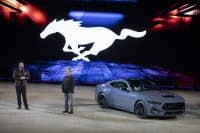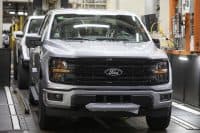
Sales of light trucks in October accounted for 63% of all vehicle sales in the United States for the month. Car sales fell nearly 10% year over year in October, while light truck sales rose 7.1% in the month. At the current sales rate, light truck sales are expected to hit about 10.6 million in 2016, the highest total ever.
This is particularly good news for the Detroit Three: Ford Motor Co. (NYSE: F), General Motors Co. (NYSE: GM), and Fiat Chrysler Automobiles N.V. (NYSE: FCAU). Light trucks are not only the best-selling vehicles for these three carmakers, the vehicles are also the most profitable.
The auto industry’s definition of light truck is considerably broader than you might expect, and that accounts for the huge number of unit sales expected in 2016. Where consumers might think full-size and compact pickup trucks are the sole inhabitants of the light truck category, the industry tosses in any vehicle that carries a gross vehicle weight rating of up to 10,000 pounds. That broadens the definition of a light truck to include minivans, cargo vans, sport utility vehicles (SUVs) and crossovers, along with a few other lower selling styles.
For example, Chrysler’s compact PT Cruiser has been categorized by FCA as a light truck. So have the Subaru Outback, the Toyota RAV4 and the Honda CR-V. The broad government definition of light truck gets stretched by automakers primarily in order to meet mileage rating targets.
According to Kelley Blue Book’s monthly sales report for October, in the small/mid crossover, SUV and minivan segment, year-to-date sales totaled 5.87 million units. In the full-size crossover, SUV, truck and van segment, sales through October totaled 2.94 million. Extrapolating from about 875,000 unit sales in both segments during October, full-year sales could reach 10.6 million.
Full-size pickup sales in the first 10 months of 2016 total 1.83 million, up 2.6%, and midsize pickup sales (for example, Chevy Colorado, Toyota Tacoma) are up 25.1% to 371,072. Full-size SUV/crossover sales are up 18.8% to nearly 266,000, and midsize SUV/crossover sales are up nearly 2% to 1.68 million.
At least some industry players see more of the same in 2017. AutoNation Inc.’s (NYSE: AN) Mike Jackson said as much on the company’s third-quarter conference call:
I think [2017] looks a lot like ’16 with more movement towards trucks. The only restriction has been installed productive capacity. … And that is certainly good for the industry overall to have. It’s more profitable for the manufacturers on the truck side than on the car side.
Automotive News cited GM chief economist Mustafa Mohatarem: “Key fundamentals like job security, rising personal incomes, low fuel prices, and low interest rates continue to provide the environment for a very healthy U.S. auto industry.” Will carmakers sell more than 11 million light trucks in 2017?
In 20 Years, I Haven’t Seen A Cash Back Card This Good
After two decades of reviewing financial products I haven’t seen anything like this. Credit card companies are at war, handing out free rewards and benefits to win the best customers.
A good cash back card can be worth thousands of dollars a year in free money, not to mention other perks like travel, insurance, and access to fancy lounges.
Our top pick today pays up to 5% cash back, a $200 bonus on top, and $0 annual fee. Click here to apply before they stop offering rewards this generous.
Flywheel Publishing has partnered with CardRatings for our coverage of credit card products. Flywheel Publishing and CardRatings may receive a commission from card issuers.
Thank you for reading! Have some feedback for us?
Contact the 24/7 Wall St. editorial team.




